CNC Turning Service
China high-quality precision CNC turning services you can trust. Competitive pricing and fast lead times.
- Over 60 Certified Materials
- ±0.005mm Tight Tolerance
- Custom Finishes
- Lead times from 7 days
Save 30% on average!

Expert CNC Turning Services From China
Are you looking for a reliable, quick-turn supplier of CNC-turned parts?
AT-Machining is a leading manufacturer of CNC-turned parts delivering excellent quality flexibly. Our highly skilled engineers, designers, and procurement teams ensure our services are provided on time and within budget.
Our state-of-the-art CNC turning centers & lathes, combined with various finishing options, make us the perfect choice for your precision manufacturing requirements, from prototyping to production runs.




Why Order CNC Turned Parts From Us
Rapid Turnaround
We’re committed to reducing friction at every stage, so you can be as delighted with the speed of your CNC Turned parts’ arrival as you are with their exceptional quality. Order now to receive your parts in as little as 5 days!
A Wide Variety Of Materials
We offer over 60 production-grade materials including metal, plastic, and ceramic, and take great care to ensure the right material is used for every part.
High Accuracy
Our standard CNC tolerance is +/- 0.127mm, and when you use our tolerance configurator, you can expect precision machining to be +/- 0.005mm.
Perfect Finish
We offer high-quality finishing processes for most CNC Turned parts; including anodizing, polishing and plating, heat treatment, powder coating, and more.
Our Maximum capabilities for CNC turning
| Part size limitations | Metric units | Imperial units |
|---|---|---|
|
Maximum part diameter |
508 mm |
20 inch |
|
Maximum part length |
1066.8 mm |
42 inch |
|
Maximum swing over the carriage |
355.6 mm |
14 inch |
|
Maximum spindle through-hole |
50.8 mm |
2 inch |
Maximum speed: 2000RPM
Motor power: 750W
CNC Turning General Tolearances
From intricate medical and aerospace designs to complex industrial parts, our ISO 9001-certified company creates precision components with the highest level of accuracy. We utilize CNC turning lathes for complex machining projects requiring tight tolerance specifications up to ±0.005” – as close as a few thousandths of an inch! Our standards for metals follow ISO 2768-m while plastics adhere to requirements set by ISO 2768-c.
| Type | Tolerance |
|---|---|
|
Linear Dimension |
+/- 0.025 mm +/- 0.001 inch |
|
Hole Diameters (not reamed) |
+/- 0.025 mm +/- 0.001 inch |
|
Shaft Diameters |
+/- 0.025 mm +/- 0.001 inch |
|
Part Size Limit |
950 * 550 * 480 mm 37.0 * 21.5 * 18.5 inch |
CNC turning design guidelines
Our CNC machining experts have carefully compiled the ideal characteristics for creating precision components. This table shows what works best, and also presents any technical limits to keep in mind during production.
| Feature | Recommended Size | Feasible Size |
|---|---|---|
|
Min. Feature Size |
Ø 2.5 mm |
Ø 0.5 mm |
|
Internal Edges |
R 8 mm |
R 0.25 mm |
|
Minimum Wall Thickness |
0.8 mm (for metals) 1.5 mm (for plastics) |
0.5 mm (for metals) 1.0 mm (for plastics) |
|
Holes |
Diameter:standard drill bit sizes Depth: 4 x diameter |
Diameter: Ø 0.5 mm Depth: 10 x diameter |
|
Threads |
Size: M6 or larger Length: 3 x diameter |
Size: M2 |
We are here to solve your problem and delivery your needs
Materials for CNC Machining Parts
AT offers a wide variety of materials for custom CNC machining, plastic, and metal, including but not limited to:
CNC Metals
Aluminum: Aluminum’s strength-to-weight ratio, affordability, and recyclability have made it widely used across industries worldwide.
Alloys: 6061-T6, 7075-T6, 2024, 5052, 6060, 5083, 2017, 6082
Finishing Options: Alodine, Anodizing Types II, III, III + PTFE, ENP, Media Blasting, Nickel Plating, Powder Coating, Tumble Polishing
Stainless steel: Stainless steel’s corrosion resistance and ductility make it ideal for long-term exposure to elements and easy shaping into different forms
Finishing Options: As machined, Bead Blasted, Polishing, Decorative Chrome Plating, Powder Coat, Nickel Plating, Gold Plating, Silver Plating
Alloys: SS303, Stainless Steel 304/304L, Stainless Steel 316/316L, Stainless Steel 17-4, Stainless Steel 416, etc.
Alloy Steel: Alloy steel is steel mixed with elements like manganese, nickel, and chromium to enhance its strength, hardness, corrosion resistance, and durability, tailored to meet specific application needs.
Alloy: AISI 1215, AISI 4140, AISI 4340, AISI 8620, AISI 4130
Finishing Option: Polishing, Plating, Painting, Powder Coating and etc.
Tool Steel: Tool steel is a type of high-carbon and high-alloy steel that is specifically designed to be used in the manufacture of cutting tools, dies, and molds. It is valued for its high hardness, wear resistance, and toughness, which make it suitable for applications where the tool is subjected to repeated impacts or stresses.
Alloy: A2 Tool Steel, D2 Tool Steel, O1 Tool Steel, S7 Tool Steel, M2 Tool Steel
Finishing Option: Bead/Sand Blast, Polishing, Plating, Painting, Powder Coating, Heat Treatment and etc.
Brass: Brass is an alloy of copper and zinc, especially metal material with more than 20% zinc content, which is the most commonly used metal material in cnc machining
Finishing Options: Nickel Plating, Bead Blasted, Gold Plating, Silver Plating
Alloy: C360, C260
Copper: Copper is a soft, malleable metal with excellent thermal and electrical conductivity, making it an essential material in many industries.
Grade: C10100, C11000, C12200, C14500, C17200
Finishing Option: Plating, Polishing
Titanium:Titanium has a low density and high strength, making it ideal for applications that require a strong yet lightweight material, such as aerospace, automotive, and biomedical industries. It is also highly resistant to corrosion and can withstand exposure to many chemicals and environments
Alloy: Ti-6Al-4V, Ti-6Al-2Sn-4Zr-2Mo, Ti-3Al-2.5V
Finishing Option: Polishing, Anodizing, Sandblasting, Chemical etching, Laser engraving and etc.
CNC Plastics
POM (Delrin/Acetal): High stiffness, good moisture resistance, high wear-resistance, and low friction, easy to machine
Color: White, black, brown
Grade: POM-C, POM-H, UV stabilized POM, Food-Grade POM
PMMA: PMMA is commonly known by the trade name “acrylic” or “plexiglass”. It is a lightweight and shatter-resistant material that is often used as a glass substitute in applications such as skylights, displays, signage, and lenses
Color: Transparency
Grade: Extruded PMMA, Cast PMMA, Impact-Modified PMMA, UV-Stabilized PMMA, Heat-Resistant PMMA
PEEK: PEEK is a high-performance engineering thermoplastic with excellent mechanical, chemical, and thermal properties, short for Polyether Ether Ketone
Color: Beige with no transparency
Grade: Unfilled PEEK, 30% glass-fiber reinforced PEEK, 30% carbon-fiber-reinforced PEEK, Bearing Grade PEEK
ABS: ABS is tough, rigid, and lightweight, making it an excellent material for use in applications such as automotive parts, toys, electronic housings, and consumer goods. It is also resistant to impact, chemicals, and heat, making it a popular choice for use in harsh environments
Color: ABS is naturally opaque and comes in a range of colors including black, white, and gray
Grade: General purpose ABS, Flame retardant ABS, High impact ABS, Heat-resistant ABS
Nylon: Nylon is a strong, durable, and elastic material that is commonly used in textiles like clothing and ropes. Its resistance to abrasion, chemicals, and moisture makes it popular for industrial applications, such as gears, bearings, and automotive components
Color: Nylon is often used in its natural off-white or slightly yellowish color
Grade: Nylon 6, Nylon 6/6, Nylon 11, Nylon 12
PTFE: PTFE(Teflon) is a high-performance plastic material known for its exceptional chemical resistance, low friction coefficient, and high-temperature resistance
Color: The color of PTFE is typically white or off-white
Grade:
PVC: PVC stands for polyvinyl chloride, which is a synthetic thermoplastic polymer that is widely used in various applications. PVC is a versatile material that can be rigid or flexible
Color: clear or opaque
Grade: UPVC, PPVC, CPVC
PEI: PEI has excellent mechanical, thermal, and electrical properties, as well as good chemical resistance
Color: Amber or brownish color
Grade: Unfilled PEI, Glass-Filled PEI, Carbon-Filled PEI, Ultem PEI
Surface Finish Options for CNC Turned Parts
AT-Machining offers a wide selection of surface finishes to improve the surface qualities of CNC-turned parts. The surface finishes applied after machining can change the appearance, surface roughness, hardness, and chemical resistance of the produced parts.
| Name | Description | ||
|---|---|---|---|
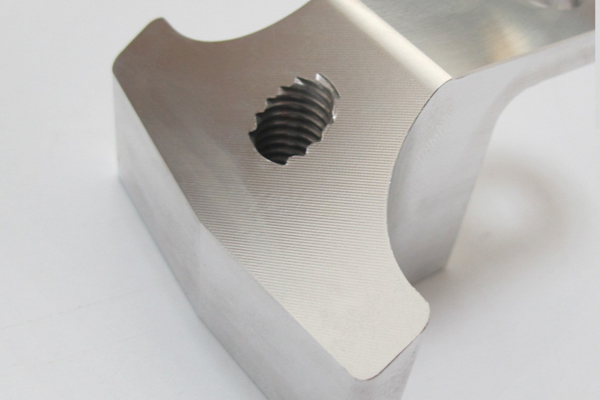
| As machined | The machined aluminum parts are left with visible tool marks and potentially sharp edges and burrs, which can be removed upon request. | |
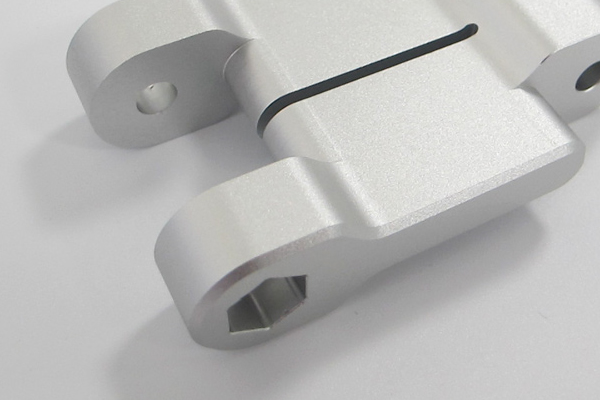
| Bead Blasted | Give the machined parts a smooth and uniform matte surface finish, thereby removing tool marks. | |

| Polishing | Creating a smooth and shiny surface by manually polishing in multiple directions or by applying a chemical polish treatment. | |
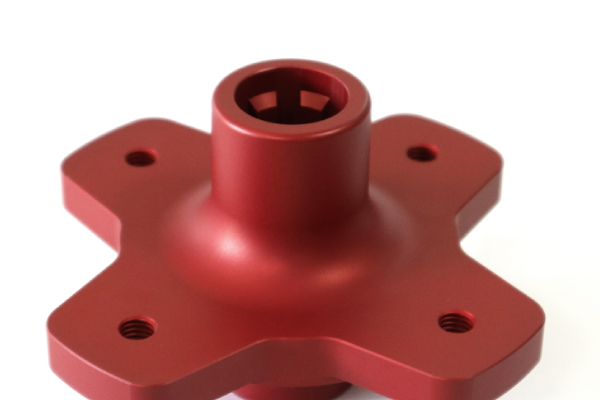
| Anodizing | Type II (Anodizing color or clear) or Type III (Anodizing hard coat) Anodizing does not cover tool marks unless bead blasted beforehand. | |

| Chromate Conversion Coating | Increase the part's corrosion resistance while retaining its conductivity. RoHS compliant. | |

| Decorative Chrome Plating | Enhance aesthetics and durability of the cnc aluminum components. | |
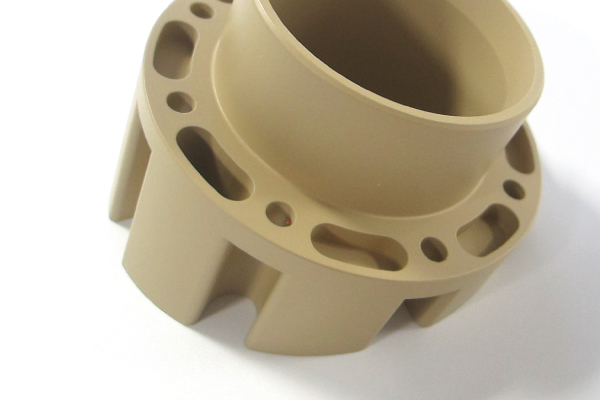
| Powder Coat | Applying powdered paint to the components and then baking it in an oven, which results in a stronger, more wear- and corrosion-resistant layer that is more durable than traditional painting methods. | |
Gallery of CNC Turning and Lathe Parts
We machine rapid prototypes and low & large-volume production orders for customers in multiple industries: medical devices, aerospace, automotive, defense, electronics, hardware startups, industrial automation, machinery, marine and robotics, and many more.
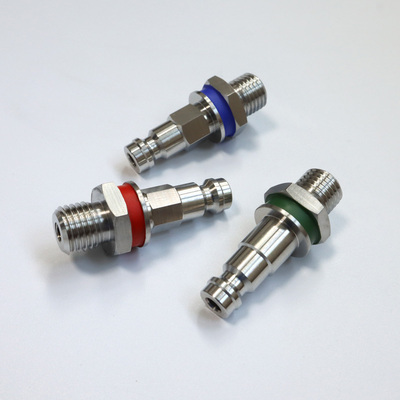

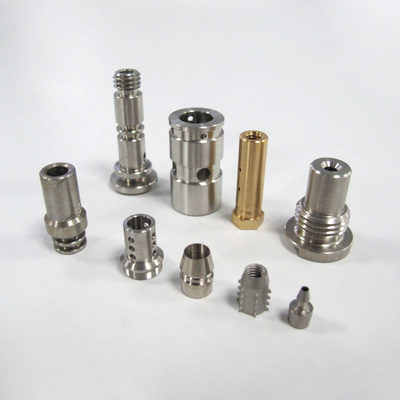

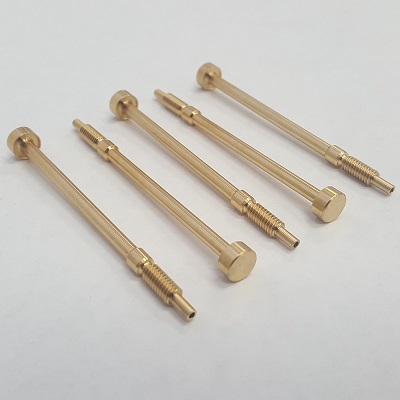

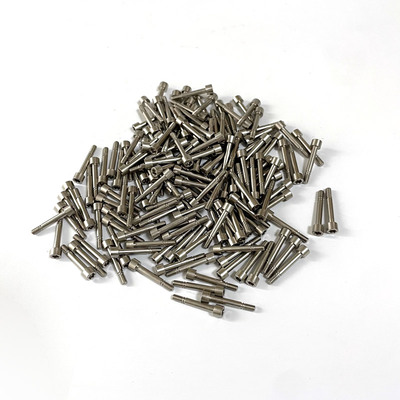
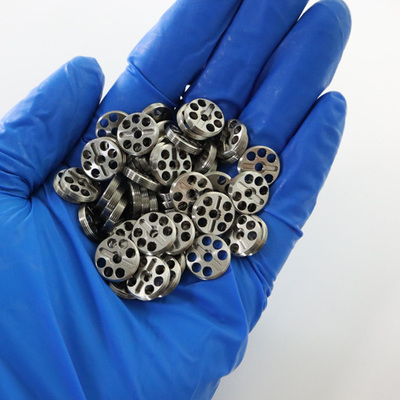
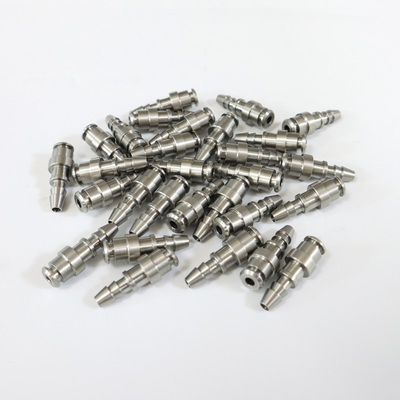
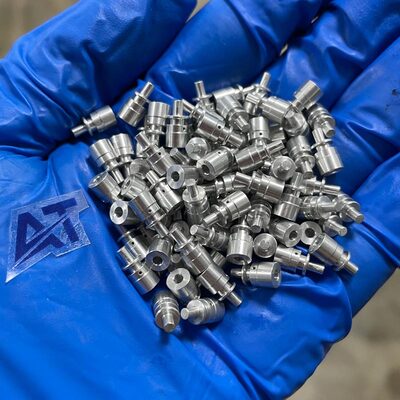


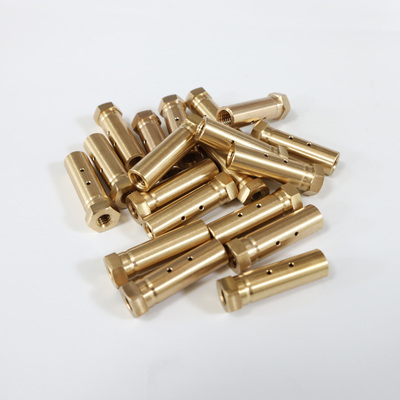

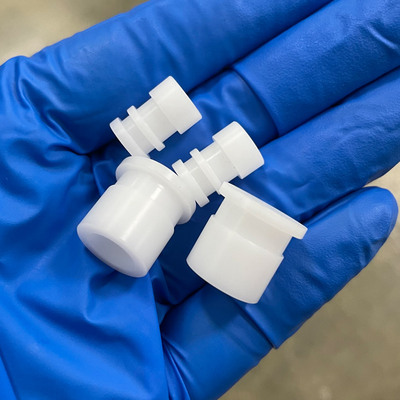
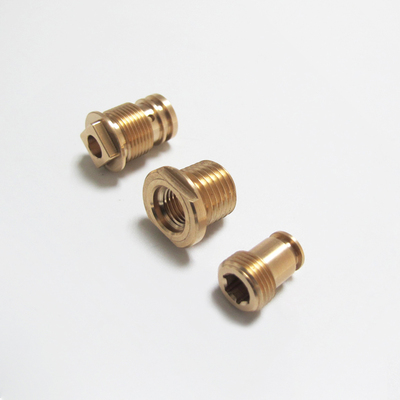

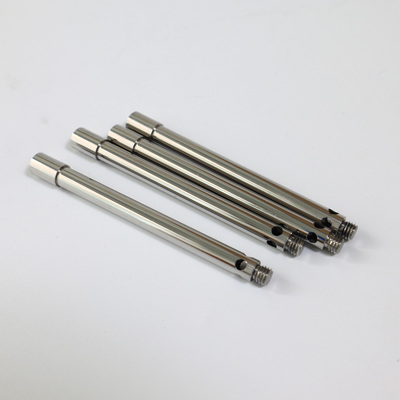
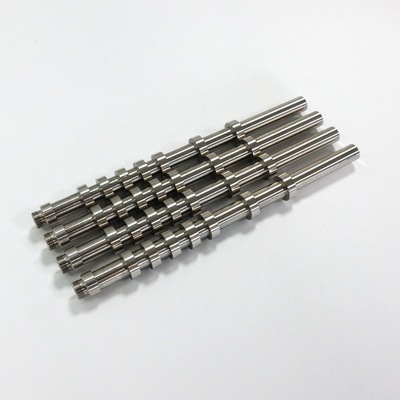
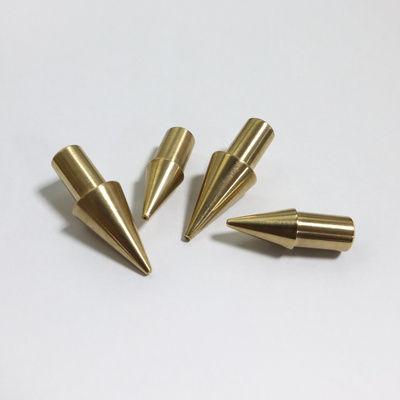
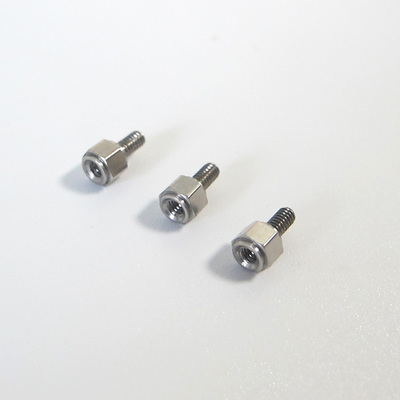
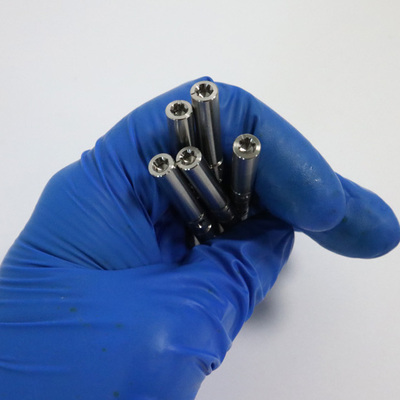
Overview: What is CNC Turning?
The Basics Of CNC Lathes
CNC lathe machines sometimes referred to as live tooling lathes, are an excellent choice for creating symmetrical, cylindrical or spherical parts. These machines utilize a workpiece that rotates along a vertical or horizontal axis while a cutting instrument moves around it on a linear path. This cutting process is referred to as turning. As a result of their precision and efficiency, CNC lathes are often used in a variety of manufacturing environments.
How CNC Turning Works
CNC lathes use a subtractive method to achieve the desired shape, starting with the creation of G-Code. Once the G-Code is ready, a solid bar, or blank, of raw material is loaded into the chuck of the lathe’s spindle. The chuck securely holds the workpiece in place while the spindle rotates. Once the spindle reaches operating speed, a stationary cutting tool is introduced to the workpiece to remove excess material until the desired shape is achieved. This precise cutting method and advanced technology allow CNC lathes to create an array of shapes with high accuracy and consistency.
Types Of CNC Lathes
2-axis CNC lathes and Swiss-type lathes are the most prevalent types of lathes. However, Swiss-type lathes have unique features, such as stock material feeding through a guide bushing, which enables close-in cutting at the point of support. This attribute is suitable for slender, lengthy turned parts and micromachining. Additionally, some Swiss-type lathes are equipped with a second tool head that functions as a CNC mill. This feature saves costs since it allows the lathe to perform multiple machining operations without the need for another machine. As a result, Swiss-type lathes are cost-effective for complex turned parts.
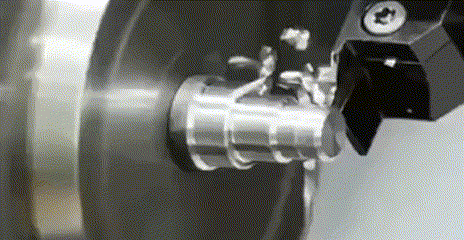
Applications of CNC Turning

Automotive
CNC turning is commonly used in the automotive industry to produce precision cylindrical components such as engine crankshafts, drive shafts, and brake rotors.

Rapid Prototyping
With its vast material range, low unit cost, and swift production capabilities, CNC stands out as an excellent alternative for rapid prototyping.

Aerospace
CNC turning is an essential process in the aerospace industry for manufacturing precision cylindrical components like turbine parts, hydraulic components, and landing gear shafts.

Industrial machinery
CNC turning is used in the industrial machinery sector to produce high-precision cylindrical components such as gears, couplings, and shafts.

Medical equipment
CNC turning is utilized in the medical device industry to create precision cylindrical components for various medical devices like surgical instruments, implants, and prosthetics.

Defense Industry
CNC Turning is widely used in the defense industry to create highly accurate and cylindrical components like artillery shells, gun barrels, and missile casings.
Our Quality Assurance
Our company has a strict quality control system in place to ensure that all products meet customer requirements. Before delivery, we perform comprehensive testing of our customer’s products to ensure they meet specifications, including dimensional accuracy, surface finish, hardness, and precision.
We utilize computerized measuring equipment to verify critical dimensions, ensuring that each product we produce is of the highest quality.
Our commitment to quality ensures that every customer receives their products on time, with the highest level of accuracy, and in accordance with their requirements.
CNC Turning FAQs
CNC milling and CNC turning are two distinct machining processes that differ in how they operate, the types of machines used, and the parts they can produce.
CNC milling uses a rotating cutting tool that moves across a stationary workpiece to remove material from its surface. The milling process can produce a wide range of geometries, including flat and inclined surfaces, slots, and grooves.
CNC turning, on the other hand, rotates the workpiece while the cutting tool remains stationary, shaping the material into the desired shape. It is typically used to produce cylindrical parts and is ideal for creating symmetrical components like shafts, pins, and bushings.
In summary, CNC milling is ideal for producing parts with complex shapes and geometries, while CNC turning is perfect for creating cylindrical parts. Both processes provide high levels of precision, consistency, and efficiency while reducing the need for manual labor.
CNC lathes and turning centers are not just two names for the same machine – they actually perform different tasks! Lathes generally rotate a part to create circular shapes, but with more advanced features like facing, threading, knurling drilling and reaming as well as taper turning capabilities; Turning Centers can help you produce even more intricate pieces.
- Only Rotatable Components Are Permitted
- Parts May Need Many Procedures and Machines
- Severe tool wear
- The processing produces a lot of Scrap
Rough turning and finish turning are the two stages of the turning process used to make machined parts. Here are the primary differences between them:
- Cutting Depths: Rough turning removes large amounts of material quickly to achieve a particular shape with a relatively heavy cut depth. Finish turning uses smaller cutting depths to provide an improved surface finish and highly accurate dimensions.
- Speed: Rough turning is commonly done at higher speeds to remove material quickly, while finish turning is performed at lower speeds to provide a smoother surface finish and more precise cuts.
- Tool Selection: Because rough turning demands a heavier cut, it frequently employs larger and more robust tool inserts. Finish turning, on the other hand, generally utilizes smaller and lighter inserts for improved surface finishes.
- Cutting Path: Rough turning typically employs a straight cutting path, while finish turning may use a technique known as “light cuts,” which involves the tool following a slightly curved path.
Both stages are essential in the turning process, with rough turning used to remove bulk material and produce the desired shape, and finish turning used to refine the size and surface finish of the machined part.
Through the power of CNC turning, a multitude of parts necessary for production in a variety of industries can be crafted – from automotive components and aeronautical components to medical equipment pieces and toy parts. From hubs to flywheels, this technology is an invaluable tool that continues — day after day — powering countless essential items we use daily.
Higher Precision: CNC turning offers significantly higher precision than manual turning, allowing for extremely accurate machine parts.
Greater Efficiency: CNC lathes can complete multiple operations in a single setup, reducing the time and cost involved in producing machined parts.
Versatile Applications: CNC turning can be applied to an extensive range of materials, from metals to plastics, allowing for a diverse range of applications.
Consistent Quality: CNC turning ensures that every machined part is identical in design and output, guaranteeing consistent quality throughout production.
Lower Costs: With its high efficiency, automated operation, and consistent quality, CNC turning offers lower manufacturing costs in the long run, as compared to traditional methods.















